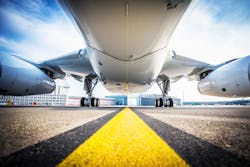How Autonomous Vehicles Fit in the Future of Airports
They are coming, it’s just a matter of when, says Chris DiPrima, airport planner at San Francisco International Airport (SFO). With a team of industry professionals, he helped create a roadmap for the future of autonomous vehicles at airports for the 2017 Airport Consultants Council (ACC) Young Professionals Innovation Competition, which his team won.
“With that creative and flexible space to think things through, we didn’t have the pressures of having somebody providing constraints, so we were able to talk to NASA and other ground service equipment companies to get what we needed to create precision and create a roadmap for what the future could be,” explains Michelle Fong, an architectural assistant at SFO, where she works with DiPrima in the airport’s Planning, Design & Construction Department.
Along with consultants Joseph Gale, an aviation environmental specialist at RS&H in San Francisco and Justin E. Divens from HMMH, the team considered and detailed autonomous taxiing technology possibilities for airports. NASA Ames Research Center is located close to SFO, so DiPrima and Fong were excited to work closely with Robert Morris, a senior researcher in Computer Science in the Exploration Technology Directorate, Intelligent Systems Division.
“It’s really a lot of their technology that we integrated into this project,” DiPrima explains. “I do think in certain situations autonomy is definitely coming, especially in places as controlled as an airfield. The economics make an argument for it, on their own, and then we get these wonderful potential benefits in terms of reduced emissions and increased margins of safety, as well as the ability to operate the airfield and aircraft holding positions, better.”
Why Autonomous?
The team identified current taxiing procedures, but also the constraints that came with them. Capacity issues, human error and fuel inefficient aircraft topped the list, and were issues that propelled their look at an autonomous solution. In early spring 2017, the research began in earnest and the project was submitted for competition in August.
This provided the team a framework to look at self-driving vehicle possibilities at SFO and focus on ideas that have actual potential on the airside of the airport. In favor of the solution, DiPrima explains that the taxiing process is a stable environment with standardized signage and markings, cooperative vehicles and defined paths. That led to the idea of the self-driving aircraft tug.
The team feels that as ground control transitions to the FAA’s DATACOMM automatic messaging, communications with autonomous vehicles will be simpler and the tug can communicate directly with the tower. Pilots then remain in the loop and retain final responsibility for their aircrafts, supervising the autonomous taxiing process.
Gale explains that SFO’s overnight hangars and their remote parking areas made an excellent case study for this project. If an aircraft arrives late at night, but isn’t scheduled to leave until the next morning, the planes are parked in a hangar to relieve SFO’s gates for other landing aircraft.
He adds that the technology has began progressing more in Europe through Lufthansa’s work with Taxibot from Israel Aerospace Industries (IAI) and TLD, as well as various automations in London and Germany.
“The conference where we presented this was all talk of an automated airfield,” Gale notes.
A Plethora of Benefits
Aircraft account for roughly 3 percent of global greenhouse gas emissions, Gale explains, and says that any way to lessen that is a win.
From the operational viewpoint, DiPrima concurs – saying there are not a lot of airports with extra gates for aircraft to sit at for hours on end. Conversations with Lufthansa peers told the team the same thing, and the German airline’s experience has shown a significant benefit in holding times.
“Instead of having to push the aircraft back, wait for the engines to run up, disconnect the tug, bring all the people back to the gate, they could just back up and move,” he explains.
Autonomous taxiing would allow airports to react more nimbly to the need for long-distance towing, DiPrima explains, and references Morris’ research at NASA, which has focused on looking at autonomous technology for remote towing, but also to and from the end of runways.
The operational benefits of decreasing delays in logistics, improving coordination with ramp and tower controls, reducing pilot workload and reducing jet blast near terminals also translate to environmental advantages. Less diesel fuel consumption and emissions matter.
“Saving 20 minutes worth of fuel as you taxi on the ground translates to money saved and less damage to engines,” says DiPrima, who adds this then means better economics for everyone. Reduced fuel burn also reduces wear and tear on engines, landing gears, and less chance of ingesting debris into an engine.
This then leads to safety benefits.
Fong’s focus in the project was the safety improvements autonomous vehicles and taxiing would provide.
“All the data would inform you of where everything is in every moment, to make the best decision at that point, and then eventually it would be more hands-off as well in terms of decision-making,” she adds. “It would reduce human errors and make processes more precise.”
She says the extra check allows the device to know where it is, what’s open, what’s closed and eliminate miscommunications. The ground crew, gate crew and even maintenance teams benefit with autonomous taxiing, as their safety is considered with fewer plane movements.
Industry Efforts
DiPrima says the team detailed many off-the-shelf solutions which exist today and how they could be leveraged into a cohesive system for autonomous taxiing at airports. From surface planning and scheduling, and systems interfacing technology to the actual sensors and tugs for autonomy, the team took time to compose a comprehensive solution for airport autonomous taxiing.
Now, all they need is an airline partner to implement it.
“This is definitely a cross-disciplinary approach,” adds Fong. “There are entities involved outside of the airports. These are existing technologies, but nobody has put them all together yet to get the final product we want. We’re on the cusp of that, which is what this project is all about.”
With tried and true technologies available at their fingertips, Fong adds that the space to make this happen will come through the airports, airlines and ground service providers.
“We would love to have an airline partner willing to explore this further, because we as the airport would love to act as a conduit for innovation,” DiPrima adds, and explains that sooner than later parts of this will be automated, but it will be a progressive process.
“It won’t be a world in which you show up in a robot car, never see a human, the bags are whirring around by themselves,” he jokes. “We tried to show milestones along the way that could be reached as automation was added in a supervised way and then capabilities built up.”
Fong agrees. She says the industry will approach autonomous vehicles methodically, and integrate the technology into existing systems first, then safely fold it into more operations.
“This is not a fast track solution, so we are thoughtfully and carefully considering what is the best way to introduce it into current operations,” she adds.
They say NASA Ames has advanced at this work already – looking at autonomous vehicles from the technology, but also interface perspective.
“There are already standard interfaces that have been developed and used by FAA, so we are leveraging that existing interface, just adding the new element of the self-driving tug on top of it,” DiPrima notes.
The way forward, he concludes, is to incrementally build up an autonomous system which will be safer, more cost effective and more operationally efficient for air industry professionals worldwide.
About the Author

Jen Bradley
Jen Bradley, owner of Bradley Bylines, is an aviation writer based in East Troy, WI. She may be reached via her website at www.bradleybylines.com.
